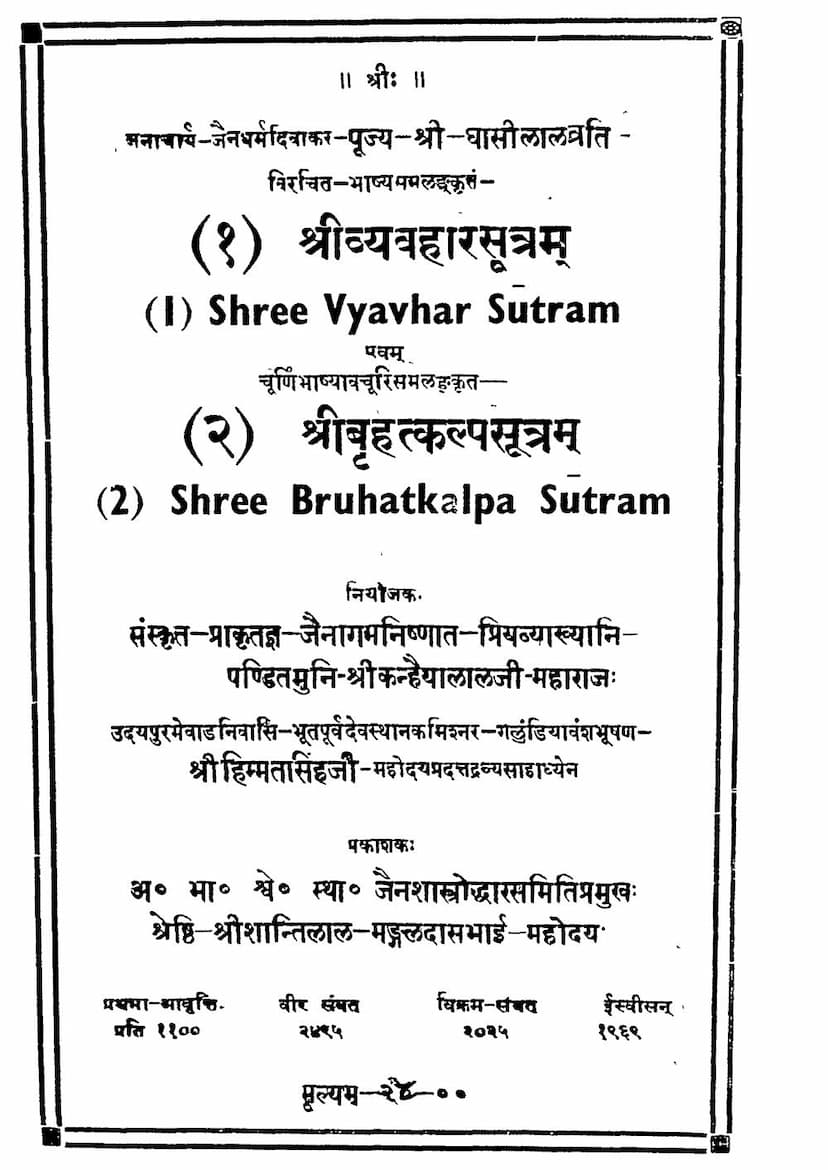Vyavaharasutram Evam Bruhatkalpsutram
Added to library: September 2, 2025

Summary
The provided text is a digital copy of the Vyavaharasutram and Brihatkalpasutram, published by the Akhil Bharat Shwetambar Sthanakwasi Jain Shastrodhara Samiti. The book, compiled by Ghasi Lal Maharaj and annotated by Muni Sri Kanhaiyalalji Maharaj, was made possible through the financial support of Shri Himmat Singhji of the Galundia lineage.
The first few pages contain introductory material, including a devotional invocation to Lord Mahavir (Shree Veetragay Namah), acknowledgments of supporters, and an introduction to the text. The compiler, Ghasi Lal Maharaj, is described as a Jain Acharya and "Jain Dharm Diwakar" (Sun of Jain Dharma), and the annotator, Muni Kanhaiyalalji Maharaj, is lauded for his mastery of Jain Agamas and his ability to explain complex texts.
The bulk of the provided text is a detailed table of contents (विषय अनुक्रमणिका) for the Vyavaharasutram, meticulously organized by chapters (उद्देशक). Each sutra (सूत्र) is listed with its corresponding topic (विषय) and page number (पृष्ठसं.). The sutras cover a wide range of topics concerning the conduct and rules for Jain monks and nuns (bhikshus and bhikshunis).
The content of the Vyavaharasutram, as detailed in the table of contents, includes:
- Chapter 1 (Prathamo'deshak): Primarily focuses on penance (prayshchitta) and purification rituals for violations related to monthly, bimonthly, quarterly, half-yearly, and annual observances (pariharsthana). It also deals with the consequences of interacting with those who have violated these rules and the proper procedures for confession and penance.
- Chapter 2 (Dwitiyo'deshak): Continues the discussion on penance and purification, particularly addressing scenarios involving multiple monks, those in specific restricted vows (pariharkalpasthitabhikshu), and those who are mentally unstable or have committed serious offenses (kuśīla, avasannavihāra, etc.). It also covers rules for monks who leave the monastic community and the procedures for their re-initiation.
- Chapter 3 (Tritiyo'deshak): Focuses on the qualifications and procedures for appointing senior monks (acharya, upadhyay, ganavachhedak) based on their scriptural knowledge and conduct. It addresses various scenarios of misconduct and the associated penalties or remedial actions.
- Chapter 4 (Chaturtho'deshak): Covers rules related to seasonal conduct (Hemanta, Grishma, Varsha), the permissible conduct of monks and nuns when accompanied by others (e.g., atma-dwitiya, atma-tritiya), and the procedures for re-establishment in a monastic community after leaving it or violating rules.
- Chapter 5 (Panchamo'deshak): Deals with rules concerning living arrangements, particularly for nuns, regarding their movements and stays during different seasons, and their interactions with male monks and laypeople. It also discusses restrictions based on the purity of the dwelling.
- Chapter 6 (Shashtho'deshak): Addresses rules concerning monks visiting their homes or relatives, the rules for accepting food from various sources, and the procedures for handling prohibited items. It also covers purification rituals for various transgressions, including those related to sexual misconduct and impure associations.
- Chapter 7 (Saptamo'deshak): Continues with rules related to inter-monastic interactions, particularly concerning purity, interactions with laypeople, and rules regarding prohibited actions in specific contexts. It discusses rules for interacting with those who have committed transgressions and the appropriate responses.
- Chapter 8 (Ashtamo'deshak): Covers rules regarding the acceptance and use of various items, particularly those related to lodging (shayya), bedding, and other necessities. It delves into the conditions under which certain items can be accepted or rejected, considering factors like purity, ownership, and the circumstances of the donor.
- Chapter 9 (Navamo'deshak): Focuses on rules related to specific types of food and items that can be accepted or rejected, particularly concerning the "shayya-tar" (householder who provides lodging and support to monks). It details rules for accepting offerings from different individuals and in different circumstances. This chapter also introduces the concept of specific vows or observances (bhikshu-pratima) undertaken by monks.
- Chapter 10 (Dashamo'deshak): Explains the concept of specific vows (pratima) undertaken by monks, detailing different types like saptasaptika, ashtashtika, navanavika, and dashdashaka. It also outlines the scriptural knowledge and experiential practices associated with these vows and the corresponding periods of observance. The chapter concludes with rules on various forms of devotional service (vaihavyavṛttiya) and their importance.
The text provides a granular index, indicating the depth and systematic nature of the Jain monastic code documented in these scriptures. The language used is a mixture of Sanskrit and Prakrit, typical for ancient Jain religious texts.